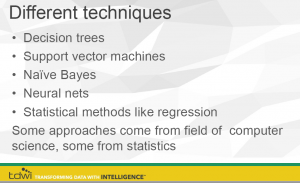The webinar I’m going to review is worth seeing for one reason: The Covenant Transportation Group case study is a fantastic example of what’s going on in BI today. It’s worth the time. IMO, skip the first and third presenters for the reasons described below.
Machine Learning – Yeah, Right…
I usually like Fern Halper’s TDWI presentations. They’re usually cogent and make sense. This, sadly, was why the word “usually” exists. The title of the presentation was “Machine learning – What’s all the hype about?” and Ms. Halper certainly provided the hype.
She started off with a definition of machine learning: “Field of study that gives computers the ability to learn without being explicitly programmed,” by Arthur Samuel (1959). The problem with the rest of the presentation is that’s still true but the TDWI analyst bought into the BI hype that the definition has changed. She presents it now as complex analytics and “Enabling computers to learn patterns.” No, it’s not – except in our sector as people and companies try to jump on the machine learning bandwagon.
Our computers, at all levels of hardware, networking and software are far faster than even a decade ago. That allows for more complex algorithms to be run. That we can now analyze information much faster doesn’t suddenly make it “machine learning.”
There’s also the problem that seems to exist with many, that of conflating artificial intelligence (AI) with expert systems. AI is simply what we don’t know about intelligence and are trying to learn how to program. When I studied AI in the 80s, robotics and vision were just becoming well known enough to be their own disciplines and left the main lump of AI problems. Natural Language Processing (NLP) was starting to do the same.
Yet another main problem I’ll discuss is another conflation of analytics and learning. Fern Harper listed and mentioned, more than once, the “machine learning algorithms.” 
Note that all except neural networks are just algorithms that were defined and programmed long before machine learning. Machine learning is the ability of the software to decide which to use, how to change percentages in decision tree branches and other autonomous decisions that directly change the algorithm. It’s not the algorithm running fast and “finding things.”
Neural networks? They’re not even an algorithm, they’re only a way to process information. Any of the algorithms could run in a neural network architecture. The neural network is software that imitates brains and uses multiple simple nodes. Teaching a neural network any of the algorithms is how they work.
Covenant Transportation Group – A Great Analytics Case Study
So forget what they tried to pitch you about machine learning. The heart of the webinar was a presentation by Chris Orban, VP, Advanced Analytics, Covenant Transportation Group (CTG), and that was worth the price of admission. It was a great example of how modern analytics can solve complex problems.
CTG is a holding company for a number of transportation firms. Logistics is a KPI. There were two main issues discussed, but worthy of mention.
The first example was the basic issue of travel routing. It’s one thing to plan routes based on expected weather. It’s quite another to change plans on the fly when weather or other road conditions (accidents, construction and more) crop up. The ability for modern systems to bring in large volumes of data, including weather, traffic and geospatial information, means CTG is able to improve driver safety and optimize travel time through rapid analysis and communications.
The second example was mentioned in the previous sentence: Driver safety. CTG, and the industry as a hole, has enormous driver turnover. That costs money and increases safety risks. They use algorithms to identify problem indicators that help identify potential driver problems before they occur, allowing both the drivers and companies to take corrective actions. A key point Chris mentions is that communications also helps build the relationships that also help lower driver turnover.
Forget that nothing he mentioned was machine learning. CTG is a great case study about the leading edge of predictive analytics and real-time (real world, real-time, that is) BI.
SAP
SAP was the webinar sponsor, so David Judge, VP and Leonardo Evangelist, SAP, wrapped up the webinar. I was hoping he’d address SAP’s machine learning, to see if it’s the real definition of the phrase or only more hype. Unfortunately, we didn’t get that.
SAP has rolled out their Leonardo initiative. It’s a pitch for SAP to lump all the buzzwords under a brand, claiming to link machine learning, data intelligence, block chain, big data, Internet of Things and analytics all under one umbrella. Mr. Judge spent his time pitching that concept and not talking about machine learning.
The CTG case study makes is clear that SAP is supporting some great analytics, so they’re definitely worth looking at. Machine learning? Still a big question mark.
I did follow up with an email to him and I’ll let folks know if I hear anything informative.
Pingback: TDWI Webinar Review: Putting Machine Learning to Work in Your Enterprise - Teich Communications